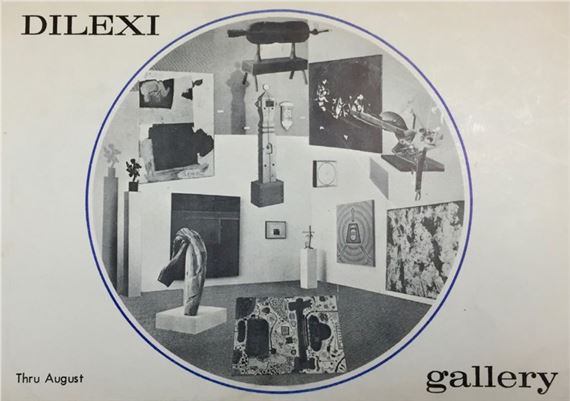Dilexi Gallery: Disparate Ontologies
The Landing is pleased to present Dilexi Gallery: Disparate Ontologies, a restaging of Dilexi's exhibition history and curatorial approach as part of a multi-venue retrospective across Los Angeles and San Francisco. Dilexi Gallery, first located upstairs from a jazz club in 1958, exhibited a wide range of styles and techniques in a rhythmic and organic dialogue. Disparate Ontologies takes inspiration from Dilexi Gallery's group shows, which highlighted the work of brilliant artists but also offered viewers a new realm of meaning through unexpected ontological pairings.
Active through 1969, Dilexi Gallery played a key role in the cultivation and development of contemporary art in the Bay Area and beyond. Taking cues from Ouspensky’s idea of the noumena and De Chirico’s metaphysics, Dilexi’s young director Jim Newman had an implicit understanding of works that engaged paradigmatic shifts, embraced new philosophical constructs, and served as vessels of sacred reverie for a new era. Dilexi artists included two generations who had fought in war and saw their work as a vehicle for both catharsis and protestation. Dilexi offered its era a secular outpost with the possibility of transforming the Cold War’s ideological crisis into a revolution of illumination.

Recommended for you
The Landing is pleased to present Dilexi Gallery: Disparate Ontologies, a restaging of Dilexi's exhibition history and curatorial approach as part of a multi-venue retrospective across Los Angeles and San Francisco. Dilexi Gallery, first located upstairs from a jazz club in 1958, exhibited a wide range of styles and techniques in a rhythmic and organic dialogue. Disparate Ontologies takes inspiration from Dilexi Gallery's group shows, which highlighted the work of brilliant artists but also offered viewers a new realm of meaning through unexpected ontological pairings.
Active through 1969, Dilexi Gallery played a key role in the cultivation and development of contemporary art in the Bay Area and beyond. Taking cues from Ouspensky’s idea of the noumena and De Chirico’s metaphysics, Dilexi’s young director Jim Newman had an implicit understanding of works that engaged paradigmatic shifts, embraced new philosophical constructs, and served as vessels of sacred reverie for a new era. Dilexi artists included two generations who had fought in war and saw their work as a vehicle for both catharsis and protestation. Dilexi offered its era a secular outpost with the possibility of transforming the Cold War’s ideological crisis into a revolution of illumination.
Artists on show
- Alan Lynch
- Ed Moses
- Frank Lobdell
- Gary Molitor
- Hassel Smith
- Horace Clifford Westermann
- Horst Trave
- Jeremy Anderson
- Joe Goode
- Joel Barletta
- John Altoon
- John Chamberlain
- Leslie Kerr
- Neil Williams
- Norman Kanter
- Paul Feeley
- Phillip Makanna
- Raymond Rocklin
- Robert Morris
- Rodger Jacobsen
- Ron Nagle
- Sam Tchakalian
- Sidney Geist
- Sidney Gordin
- William Dubin

 ARTISTS
ARTISTS













